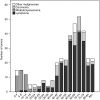Incidence of primary malignant orbital tumours in the Netherlands
- PMID: 21336252
- PMCID: PMC3171243
- DOI: 10.1038/eye.2011.9
Incidence of primary malignant orbital tumours in the Netherlands
Abstract
Aims: To describe the incidence and relative frequencies of primary malignant orbital tumours in the Netherlands from 1989 to 2006.
Methods: All registered primary malignant orbital tumours were extracted from the population-based database of the Netherlands Cancer Registry. Age-adjusted incidence of malignant orbital tumours per 10,000,000 persons per year and the estimated annual percentage change (EAPC) were computed.
Results: A total of 367 malignant orbital tumours were registered. The average age-adjusted incidence of malignant orbital tumours is 10.9. Lymphoma has a relative frequency of 67%, rhabdomyosarcoma 12%, adenocarcinoma 6%, and adenoid cystic carcinoma 5%. The incidence of primary malignant orbital tumours has been increasing in the Netherlands (EAPC +2.8%).
Conclusion: In the Netherlands, lymphoma is the most common primary malignant orbital tumour, followed by rhabdomyosarcoma, adenocarcinoma, and adenoid cystic carcinoma. The relative frequencies of the different histological tumour types are comparable to the frequencies in other parts of the world. The incidence of malignant primary orbital tumours shows a slight increase between 1989 and 2006.
Figures


References
-
- van der Sanden GA, Coebergh JW, Schouten LJ, Visser O, van Leeuwen FE. Cancer incidence in the Netherlands in 1989 and 1990: first results of the nationwide netherlands cancer registry. Coordinating committee for regional cancer registries. Eur J Cancer. 1995;31A:1822–1829. - PubMed
-
- Margo CE, Mulla ZD. Malignant tumours of the orbit. Analysis of the florida cancer registry. Ophthalmology. 1998;105:185–190. - PubMed
-
- Cheng CY, Hsu WM. Incidence of eye cancer in taiwan: an 18-year review. Eye. 2004;18:152–158. - PubMed
MeSH terms
LinkOut - more resources
Full Text Sources
Medical

